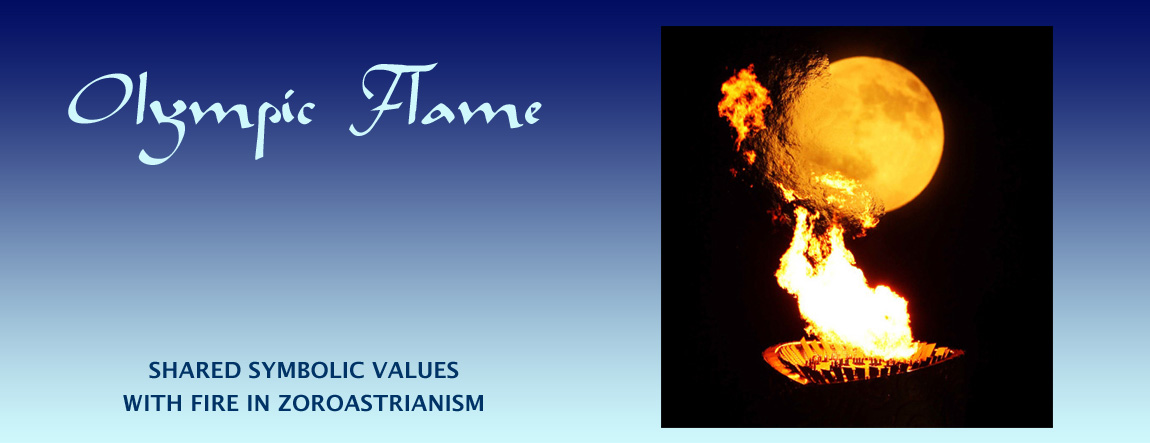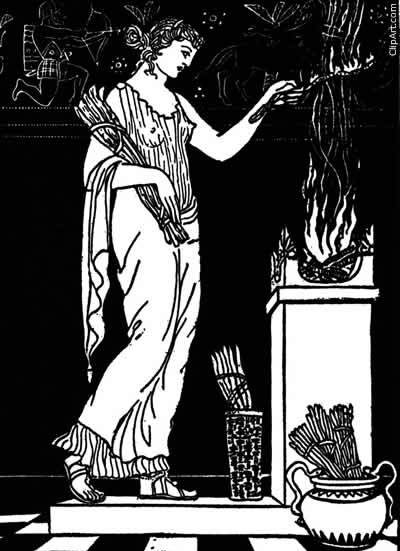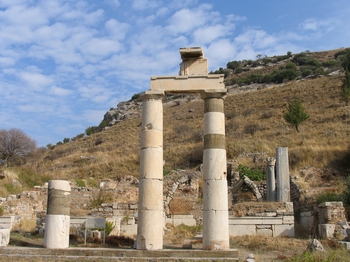
|
Image credit: 2008 Oylmpics at Babyhook at Flickr |
Page 2. Ancient Greece: Origins of the Olympic Tradition, Role of Fire in Ritual & Additional Zoroastrian-Greek Connections
Further reading:» Eternal Flame in Overview page» FireRelated reading:» Greek & Persian Relations - Achaemenian EraOrigins of the Olympic Flame Tradition
Prometheus' Theft of Fire. The TitansThe Greek traditions surrounding the lighting of the Olympic flame have rather ignominious beginnings in the theft of fire from the Olympian Greek god Zeus by Prometheus, a Titan. The Titans were a race of powerful elder gods who ruled during the legendary Golden Age. The Titans were overthrown by a race of younger gods, the Olympians who had their home on Mount Olympus. If religious developments reflected societal developments, the change may have marked a separation from older and perhaps more eastern Greek traditions. After the theft, Prometheus hid the fire in a giant fennel-stalk and gave it to the "old race" of mortals that Zeus was planning to destroy and replace with a "new race". The myth is enacted in a play written by Aeschylus (525/4-256/5 BCE), the first part of which named Prometheus Bound, survives. (Also see the Greek gods as historical personages at The Agamemnon Homepage.) Fire - the Secrets of LifeIn giving mortals the fire, Prometheus also endowed the mortals with the spark and secrets of life and became their champion. The fire revealed the secrets of knowledge, wisdom and the human spirit to humankind. Prometheus' Punishment in the Caucasus Mountains
Enraged by this act of defiance and challenge to his supremacy, Zeus had Prometheus chained to a rock in the Caucasus mountains where his liver was eaten daily by an eagle. We find mention of the Caucuses in this myth - representing the older mythology - very interesting. The Caucasus mountains are considerably east of modern Greece and formed the north-western border of ancient Aryan lands. Some authors even identify the mountain to which Prometheus was chained as Mt. Elburz which would place this myth even further east.
Greeks & Aryans in Asia Minor
At one time in history, ancient Greek lands in Asia Minor likely bordered (or were in close proximity to) western Indo-Iranian Aryan lands in present-day Asia Minor.
Parallels in Greek & Aryan Myth
Readers who are familiar with the battles between the deva and asura worshippers, a struggle preserved as a battle between their respective gods, will find some interesting parallels between the deva-asura and Olympian-Titan myths. There were twelve gods in the Titan pantheon, six male and six female. Most of the Titans were associated with nature and natural phenomena: the ocean, earth, sun, moon, memory and natural law. The twelve first-generation Titans were ruled by the youngest sibling, Cronus / Kronos (whose Roman counterpart was Saturn), who had gained power after overthrowing their father, Ouranos (Uranus), the non-anthropomorphic god of the sky and heavens at the urging of their mother, Gaia goddess of the earth. Gaia was pained by Ouranos' hatred of her children, the Titans, who he had trapped within her womb - deep within the earth - causing Gaia much suffering from the strain. (Zoroastrianism contains the concept of gaya, life.) In later Greek mythology, the goddess Persephone (see below) is also found trapped deep within the earth.
Role of Fire in Ancient Greek Ritual
The Home Hearth, Fire Altars & HestiaIn his book Greek Religion, Walter Burker starts his section on Fire Rituals with the comment "Fire is one of the foundations of civilized life." In ancient Greece, the hearth hestia, was also the name of its guardian goddess, Hestia (Roman Vesta? The Roman fire was cared for by the six Vestal Virgins) (see Wikipedia article). Hestia is thought by some writers to be an Indo-European goddess, brought by the Indo-Europeans when they came to Greece around the second century BCE. Ever-burning Fires of ApolloJust as the home fire was not permitted to die out, was too was an ever-burning fire maintained in some temples such as the temple of Apollo in Delphi, the temple of Apollo Lykeios at Argos, and the temple of Apollo Karneios in Cyrene. "Hestia, you who tend the holy house of the lord Apollo, the far-shooter, with soft oil dripping ever from your locks, come now into this house, come, having one mind with Zeus the all-wise, draw near, and withal bestow grace upon my song." (Homeric Hymn to Hestia 24). Role of Fire in RitualsWhen a member of a household died, the heart fire was extinguished and after the required period of mourning, the fire was rekindled with a fire from the state hearth. The fires on the island of Lemnos are 'purified' once a year by a community-wide ritual when all the fires on the island were extinguished for a period of nine days. Then, the fires are reignited using a fire brought by ship from the temple in Delos. When a new Greek colony was established, the flame from Hestia's public hearth in the mother city would be carried to the new settlement and a symbol of the linkage and continuity with the older community. Hestia as Goddess of the Home & PeaceHestia was the goddess of the home and household as well. In these roles, she was the guardian of correctly cooked meals and the maintenance of domestic tranquility. It was normal for an offering to be made to Hestia before and after every meal and indeed before any public offerings to other gods: "pour sweet wine in offering to Hestia both first and last" is a phrase found in Homer's ode to Hestia. Her role as peace-maker and conflict-resolver was reflected in myth where despite being the oldest (the first-born of Rhea and Kronos, and paradoxically the youngest as well) of the twelve original Olympian gods, she gave up her seat in order to tend to the sacred fire on Mt. Olympus and accommodate the newcomer Dionysus. Hestia, and thereby fire, became a symbol for civic peace and good order in a manner similar to fire being the symbol of Asha, righteous order in Zoroastrianism. As an unassuming goddess who did not partake in exploits or wars, Hestia's name does not occur frequently in Greek mythology. During the observance of the Olympic games, a truce was declared across Greece and all conflicts were to be suspended. Fires as Symbol of Divine PresenceThe fires of Hestia were considered divine and "a sudden burst of flame from the altar" was seen as a sign of divine presence. Source & Lighting of Sacred FiresSince the fires of Hestia were considered divine, the fires were lit from sources considered to be pure: the sun and by friction.
Outdoor & Indoor Fire AltarsIn a manner similar to open-air fires lit by early Aryans for their ceremonies, many orthodox Greek temples had a fire altar in the open air opposite the entrance. Some temples such as the temple of Apollo also had an inner hestia or hearth. The temples that had outdoor altars lit their fires on special occasions, while temples with indoor hearths had the ability to maintain continuous ever-burning fires.
Prytaneum / PrytaneionThe indoor hearths of Hestia were housed in a building called a Prytaneum / Prytaneion. The indoor altar of Hestia in the Prytaneum is reminiscent of the Persian Pyraetheia tended by the magi and referred to by Strabo. Outdoor Fire AltarsThe outdoor altar of Zeus at Olympia replicates the outdoor worship setting of ancient Zoroastrians who lit a fire "on high places" at times of public worship as observed by Herodotus. Fragrant FiresThe ritual fires were designed to appeal to all the senses. The materials could also be those that added fragrance to the fire's smoke and thereby to the surroundings. According to Homer, the gods too had their "fragrant altars" and the fragrance of temporal fires may have had the purpose of inducing a sacred experience in "an atmosphere of divine fragrance." The fragrance resulted from the selection of wood used as well as materials added to the fire. The use of frankincense imported from the Middle East was customary. Differences in the Ritual Use of FiresWhile there are are some striking similarities and interesting parallels between the ancient Greek and Zoroastrian use if fire in worship and ritual, there are also important differences. The Greeks appeared to adopted the Semitic custom of using fire for animals (and reportedly human) sacrifices. This concept is completely alien to Zoroastrian values which would consider a burnt offering or cremation to be a form of pollution and therefore a sin. Additional Ancient Greek-Zoroastrian ConnectionsPomegranate's RoleThe goddess Hera (Zeus' wife and sister) is often depicted holding a pomegranate (see our page on Barsom. The pomegranate is native to eastern Iran / Central Asia and not to Greece. According to a Wikipedia article, even today, the pomegranate has strong symbolic meaning for the Greeks). PersephoneThe pomegranate is also a symbolic item associated with Persephone, a name that appears to mean 'Persian-speaker', but whose meaning is given as 'destruction' (from the verb, perthein ?!) by most writers who engage in considerable mechanics to try and avoid any suggestion that Greeks might have eastern i.e. pseudo-Persian origins or connections. Even the name Perses (see below) - the ancestor of the Persians according to Greek mythology - is also taken to mean destruction. David Sacks, Oswyn Murray and Margaret Bunson in A Dictionary of the Ancient Greek World state that Persephone was worshipped before the Greeks settled in present-day Greece and was a pre-Greek, i.e. pre 2100 BCE, deity. Persephone is often depicted holding a flaming torch. Perseus & Perses
In Greek mythology, Perseus, son of Zeus and the maiden Danae, is the legendary founder of the state of Mycenae and its Perseid dynasty. [Mycenae was the dominant Greek city-state in the second millennium BCE, and a centre of Greek civilization. Today, the city's ruins are located 90 km south-west of Athens, in the north-eastern Peloponnese.]
Aia
Aia was a mythical kingdom located in the south-eastern corner of the Black Sea where it meets the Caucuses. We find mention of Aia in the myths of Phrixus and the Ram, as well as the myth of Circe in book ten of Homer's (eighth century BCE) Odyssey. It these myths, Aia was ruled by King Aeetes, a son of Helios the sun god, and Perse (or Perseis), a sea nymph. Aeetes was also the father of Chalciope, Medea (compare with Media), and a son, Apsyrtus.
Possible Origins of Greek-Persian Connections
It is our impression that Greek-Persian connections can be traced to the era following the creation of the sixteenth Aryan land, Ranghaya, the last Aryan land to be mentioned in the Zoroastrian scriptures, the Avesta (please see our map the Aryan lands). The following are some factors that lead us to this impression:
Site of interest: » Page 1. The Flame, Lighting of the Flame, Videos & Photographic TourFurther reading:» Eternal Flame in Overview page» FireRelated reading:» Greek & Persian Relations - Achaemenian Era |



